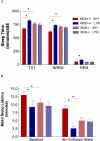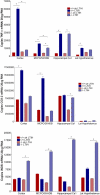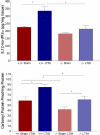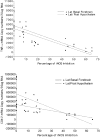Inducible nitric oxide synthase in long-term intermittent hypoxia: hypersomnolence and brain injury
- PMID: 15750040
- PMCID: PMC2718483
- DOI: 10.1164/rccm.200411-1564OC
Inducible nitric oxide synthase in long-term intermittent hypoxia: hypersomnolence and brain injury
Abstract
Rationale: Long-term intermittent hypoxia (LTIH) exposure in adult mice, modeling oxygenation patterns of moderate-severe obstructive sleep apnea, results in lasting hypersomnolence and is associated with nitration and oxidation injuries in many brain regions, including wake-active regions.
Objectives: We sought to determine if LTIH activates inducible nitric oxide synthase (iNOS) in sleep/wake regions, and if this source of NO contributes to the LTIH-induced proinflammatory gene response, oxidative injury, and wake impairments.
Methods: Mice with genetic absence of iNOS activity and wild-type control animals were exposed to 6 weeks of long-term hypoxia/reoxygenation before behavioral state recordings, molecular and biochemical assays, and a pharmacologic intervention.
Measurements and main results: Two weeks after recovery from hypoxia/reoxygenation exposures, wild-type mice showed increased iNOS activity in representative wake-active regions, increased sleep times, and shortened sleep latencies. Mutant mice, with higher baseline sleep times, showed no effect of long-term hypoxia/reoxygenation on sleep time latencies and were resistant to hypoxia/reoxygenation increases in lipid peroxidation and proinflammatory gene responses (tumor necrosis factor alpha and cyclooxygenase 2). Inhibition of iNOS after long-term hypoxia/reoxygenation in wild-type mice was effective in reversing the proinflammatory gene response.
Conclusions: These data support a critical role for iNOS activity in the development of LTIH wake impairments, lipid peroxidation, and proinflammatory responses in wake-active brain regions, and suggest a potential role for inducible NO inhibition in protection from proinflammatory responses, oxidative injury, and residual hypersomnolence in obstructive sleep apnea.
Figures





Comment in
-
Sleepiness and neurodegeneration in sleep-disordered breathing: convergence of signaling cascades.Am J Respir Crit Care Med. 2005 Jun 15;171(12):1325-7. doi: 10.1164/rccm.2503004. Am J Respir Crit Care Med. 2005. PMID: 15941842 No abstract available.
References
-
- Young T, Palta M, Dempsey J, Skatrud J, Weber S, Badr S. The occurrence of sleep-disordered breathing among middle-aged adults. N Engl J Med 1993;328:1230–1235. - PubMed
-
- Douglas NJ, Engleman HM. Effects of CPAP on vigilance and related functions in patients with the sleep apnea/hypopnea syndrome. Sleep 2000;23:S147–S149. - PubMed
-
- Patel SR, White DP, Malhotra A, Stanchina ML, Ayas NT. Continuous positive airway pressure therapy for treating sleepiness in a diverse population with obstructive sleep apnea: results of a meta-analysis. Arch Intern Med 2003;163:565–571. - PubMed
-
- Bedard MA, Montplaisir J, Richer F, Malo J. Nocturnal hypoxemia as a determinant of vigilance impairment in sleep apnea syndrome. Chest 1991;100:367–370. - PubMed
-
- Tiihonen M, Partinen M. Polysomnography and maintenance of wakefulness test as predictors of CPAP effectiveness in obstructive sleep apnea. Electroencephalogr Clin Neurophysiol 1998;107:383–386. - PubMed
Publication types
MeSH terms
Substances
Grants and funding
LinkOut - more resources
Full Text Sources
Research Materials

